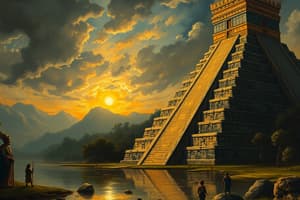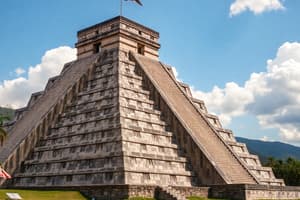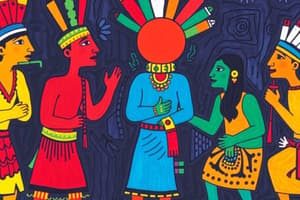Podcast
Questions and Answers
¿Qué cultura preincaica se asocia principalmente con el sitio de Caral?
¿Qué cultura preincaica se asocia principalmente con el sitio de Caral?
- Chavín (correct)
- Wari
- Nazca
- Moche
¿Cuál de las siguientes características NO se asocia directamente con la cultura Nazca en el diagrama?
¿Cuál de las siguientes características NO se asocia directamente con la cultura Nazca en el diagrama?
- Uso de 11-16 colores
- Estilo pictórico
- Exclusión de colores de EEUU: azul, verde y rojo
- Presencia de Huacas (correct)
¿Qué cultura preincaica se menciona específicamente en el texto como relacionada a la Huaca Silbador?
¿Qué cultura preincaica se menciona específicamente en el texto como relacionada a la Huaca Silbador?
- Nazca
- Wari
- Chimu (correct)
- Tiahuanaco
¿Cuál de las siguientes opciones describe mejor uno de los elementos asociados con la cultura Moche según el diagrama?
¿Cuál de las siguientes opciones describe mejor uno de los elementos asociados con la cultura Moche según el diagrama?
¿Qué cultura preincaica se asocia con elementos como 'Max Uttle' y 'Chiquiwanba'?
¿Qué cultura preincaica se asocia con elementos como 'Max Uttle' y 'Chiquiwanba'?
Flashcards
Cultura Mochica
Cultura Mochica
Cultura preincaica que se desarrolló en la costa norte del Perú, conocida por su cerámica policromada con motivos iconográficos y su tradición textil.
Cultura Nazca
Cultura Nazca
Cultura preincaica que se desarrolló en Nazca, caracterizada por su arte en cerámica y textiles.
Huaca Silbador
Huaca Silbador
Instrumento musical utilizado por los mochicas, que imita el sonido de un silbido. Su nombre deriva de huaca (templo) y silbador (silbador).
Cultura Wari
Cultura Wari
Signup and view all the flashcards
Kero
Kero
Signup and view all the flashcards
Study Notes
Pre-Inca Cultures
- Caral: Located in Supe Valley
- Ruth Shady: Archaeologist associated with Caral
- Chavín de Huántar: Known for its stonework and religious figures
- Nazca: Famous for the Nazca Lines, featuring geoglyphs
- Moche: Known for their pottery and artistic depictions of daily life
- Mochica: Developed the art of ceramics and metalworking
- Huaca de la Luna: A significant Moche site
- Tiahuanaco: Known for impressive stone structures and monumental architecture
- Chimu: Known for irrigation systems and intricate designs
- Wari: Known for its large size and significant trade connections
- Paracas: Notable for its textiles and advanced techniques
- Nasca: Known for its art, pottery, and geoglyphs
- Cultural periods: Ceramic/Pre-ceramic, Nasca, Paracas, Moche, Nazca, Wari periods
Cultural Characteristics
- Pottery styles: Various styles and colors were used, like 11-16 colors for Nazca, cream, and rose for Bicolor
- Figurines and symbols: Depictions of animals, people, and gods
- Textiles: Exquisite textiles exemplified by Paracas, demonstrating advanced weaving techniques
- Architecture: Varying structures reflecting different societies, from simple settlements to large ceremonial centers.
- Religious beliefs: Religious beliefs are reflected in art and architecture.
- Burial practices: Important aspect revealing social structure.
- Trade networks: Evidence of trade and exchange among different cultures.
- Artistic expressions: Including pottery, textiles, and monumental architecture.
Important Cultural Characteristics
- Colors: Examples include Tricolon, Huacas, and specific colors in Nazca culture.
- Symbols: Examples include Condor, Serpent, Jaguar, and other animals
- Tools: Objects used for everyday life and rituals.
- Specific Regions: Details about Nazca, Chavín, Paracas, etc.
- Time Periods: Dates associated with each culture.
Additional Details
- Tiwanaku: Known for its monumental architecture
- Chavín: Known for stonework and religious symbolism
- Nazca: Famous for geoglyphs and pottery
- Moche: Known for their complex social structure, and artistry
- Chimu: Advanced irrigation systems were a hallmark
- Cerámica: Detailed descriptions involving types of ceramics produced
- Keros: Depictions and designs
Studying That Suits You
Use AI to generate personalized quizzes and flashcards to suit your learning preferences.




